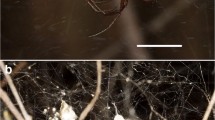Summary
The swordtail Xiphophorus nigrensis exhibits three relatively discrete male body-size classes that derive from allelic variation at the Y-linked pituitary (P) locus. Previous studies have shown that larger males have greater relative reproductive success, and that females prefer large males. We describe the mating behavior utilized by males of each size class during individual encounters with females. Small males rely on “chase” behavior, similar to the alternative mating behavior classified as ‘sneaker” in small males of other species. Large males court and intermediate-sized males court or chase, depending on their body size. There is a strong correlation between P alleles for small size (s) and large size (L) with chasing and courting, respectively. The relationship between mating behavior of males of the genotype I is ambiguous. In the closely related species X. pygmaeus, males are of size similar to smaller X. nigrensis males. Paradoxically, these males do not show the courtship display that typifies larger male X. nigrensis and many other species of swordtails, but instead often employ chase behavior identical to the alternative mating behavior in small male X. nigrensis. We suggest that historical and genetic constraints, in addition to current selection forces, might be important factors in explaining the existence of alternative mating behavior in X. pygmaeus.
Similar content being viewed by others
References
Austad SN (1984) A classification of alternative reproductive behaviors and methods for field testing ESS models. Am Zool 24:309–319
Borowsky RL (1987) Genetic polymorphism in adult male size in Xiphophorus variatus (Antheriniformes: Poeciliidae). Copeia 1987:782–787
Cade WH (1984) Genetic variation underlying sexual behavior and reproduction. Am Zool 24:355–366
Constanz GD (1975) Behavioral ecology of mating in the Gila topminnow. Poeciliopsis occidentalis (Cyprinidontiformes: Poeciliidae). Ecology 56:966–973
Dominey WJ (1980) Female mimicry in male bluegill sunfish — a genetic polymorphism? Nature 284:546–548
Dominey WJ (1984) Alternative mating tactics and evolutionary stable strategies. Am Zool 24:385–396
Falconer DS (1981) Introduction to quantitative genetics, 2nd edn. Longman, London
Farr JA, Travis J, Texler JC (1986) Behavioural allometry and interdemic variation in sexual behaviour of the sailfin molly Poecilia latipinna (Pisces Poeciliidae). Anim Behav 34:497–509
Franck D (1964) Vergleichende Verhaltensstudien an lebendge-bärenden Zahnkarpfen der Gattung Xiphophorus (Pisces). Zool Jahrb Abt Allg Zool Physiol 71:117–170
Franck D (1968) Weitere Untersuchungen zur vergleichenden Ethologie der Gattung Xiphophorus (Pisces). Behaviour 30:75–90
Gross MR (1979) Cuckoldry in sunfishes (Lepomis: Cetrarchidae). Can J Zool 57:1507–1509
Gross MR (1982) Sneakers, satellites and parentals: polymorphic mating strategies in North American sunfishes. Z Tierpsychol 60:1–26
Gross MR (1984) Sunfish, salmon, and the evolution of alternative reproductive strategies and tactics in fishes. In: Wooton R, Potts G (eds) Fish reproduction: strategies and tactics. Academic Press, London, pp 1–50
Gross MR (1985) Disruptive selection for alternative life histories in salmon. Nature 313:47–48
Heinrich W, Schroder JH (1986) Tentative findings on the phylogenetic relationships within the genus Xiphophorus with regard to the frequency distribution of sexual behavior patterns. Ber nat-med Ver Innsbruck 73:187–197
Hemens SJ (1966) The ethological significance of the sword-tail in Xiphophorus helleri (Haeke). Behaviour 27:290–315
Howard RD (1978) The evolution of mating strategies in bullfrogs, Rana catesbeiana. Evolution 32:850–871
Hughes A (1985) Male size, mating success and mating strategy in male mosquitofish (Gambusia affinis, Poeciliidae). Behav Ecol Sociobiol 17:271–278
Kallman KD (1975) The platyfish, Xiphophorus maculatus. In: King RC (ed) Handbook of genetics, vol 4. Plenum Press, New York, pp 81–132
Kallman KD (1983) The sex determining mechanism of the poeciliid fish, Xiphophorus montezumae, and the genetic control of the sexual maturation process and adult size. Copeia 1983:755–769
Kallman KD (1984) A new look at sex determination in pocciliid fishes. In: Turner BJ (ed) Evolutionary genetics of fishes. Plenum Press, New York, pp 95–171
Kallman KD, Schreibman MP, Borkoski V (1973) Genetic control of gonadotrop differentiation in platyfish, Xiphophorus maculatus (Poeciliidae). Science 181:678–680
Kodric-Brown A (1977) Reproductive success and the evolution of breeding territories in pupfish (Cyprinodon). Evolution 31:750–766
Kodric-Brown A (1985) Female preference and sexual selection for male coloration in the guppy (Poecilia reticulata). Behav Ecol Sociobiol 17:199–205
Kodric-Brown A (1986) Satellites and sneakers: opportunistic male breeding tactics in the pupfish Cyprinodon pecosensis. Behav Ecol Sociobiol 19:425–432
Rosen DE (1979) Fishes from the uplands and intermontane basins of Guatemala: revisionary studies and comparative geography. Bull Am Mus Nat Hist 162:263–375
Rubenstein DI (1980) On the evolution of alternative mating strategies. In: Staddon JER (ed) Limits to action: allocation of individual behavior. Academic Press, New York, pp 65–102
Ryan MJ (1980) Female mate choice in a neotropical frog. Science 209:523–525
Ryan MJ (1985) The Tungara frog, a study in sexual selection and communication. University Chicago Press, Chicago
Ryan MJ (1988) Phenotype, genotype, swimming endurance and sexual selection in a swordtail (Xiphophorus nigrensis). Copeia 1988:484–487
Ryan MJ, Wagner WE Jr (1987) Asymmetries in mating preferences between species: female swordtails prefer heterospecific mates. Science 236:595–597
Searcy WA, Marler P (1981) A test for responsiveness to song structure and programming in female sparrows. Science 213:926–928
Warner RR, Hoffman SG (1980) Local population size as a determinant of mating system and sexual composition in two tropical marine fishes (Thalassoma sp.). Evolution 34:508–518
Warner RR, Robertson DR, Leigh EG Jr (1975) Sex change and sexual selection. Science 190:633–638
Watt BW, Carter PA, Donohue K (1986) Females' choice of “good genotypes” as mates is promoted by an insect mating system. Science 233:1187–1190
Wirtz P (1978) The behaviour of the Mediterranean Tripterygion species (Pisces, Blenniodei). Z Tierpsychol 48:142–174
Zimmerer EJ, Kallman KD (1989) The genetic basis for alternative reproductive tactics in the pygmy swordtail, Xiphophorus nigrensis. Evolution (in press)
Author information
Authors and Affiliations
Rights and permissions
About this article
Cite this article
Ryan, M.J., Causey, B.A. “Alternative” mating behavior in the swordtails Xiphophorus nigrensis and Xiphophorus pygmaeus (Pisces: Poeciliidae). Behav Ecol Sociobiol 24, 341–348 (1989). https://doi.org/10.1007/BF00293262
Received:
Accepted:
Issue Date:
DOI: https://doi.org/10.1007/BF00293262




